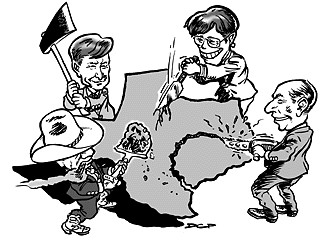Carving Up Texas
The Redistricting Forces Begin to Form Battle Lines at the Capitol
By Mike Clark-Madison, Fri., Feb. 9, 2001

"If you look at the nearly 21 million citizens in this state," says state Sen. Jeff Wentworth, R-San Antonio, "the 181 of us in the Legislature are by far the most self-interested and the least objective people to oversee redistricting." Which is exactly why the Lege won't let go of the once-a-decade job of redrawing the state's electoral maps. Who else would you trust with your life?
The task is an analytic-geometry assignment: Divide these points we call voters, distributed in a certain way over the flat surface we call Texas, into 15 (state Board of Education) or 31 (state Senate) or 32 (U.S. Congress, up two from 1990) or 150 (state House) equal groups, using the straightest lines possible. The process of redistricting is nothing quite so cerebral. The Legislature turns into a big mud pit where members flail, wrestle, and whack each other with sticks, all to ensure that their districts, or those of their friends, or those higher up the electoral ladder that they covet, end up exactly as they want them. Since there are only so many voters to go around, somebody always loses.
This time, as notes lobbyist and former Railroad Commissioner Mary Scott Nabers, "people are telling us this session is going to be different, but it probably won't be. Redistricting is always painful and never fun." She knows this at close quarters, her husband and lobbying partner Lynn Nabers having served in the Legislature (from Brownwood) for 14 years and through two redistrictings.
"Maybe after people go through this pain," he says, "they'll consider doing something different. But politicians feel they need to be in control of their own destiny. It would be better for people to have more compact districts, less crazily drawn, with more of a community of interest. But everyone thinks 'It's easier to horse-trade and get my district into shape where I can be re-elected or trade up.'" The Nabers' pessimism would seem borne out by the fate of the 1991 plans, which required two special sessions to craft and, after numerous legal challenges, were all substantially altered by court order during the decade.
The 2001 redistricting will get under way for real in early March, when the U.S. Census Bureau releases the necessary data from last year's national count. (The state-level totals came out in December, which is how we know that Texas gains two seats in the U.S. House.) If this round is different from the mind-melting blood sport of past decades, it'll be because of Wentworth, who was appointed by new Lt. Gov. Bill Ratliff to chair the Senate redistricting committee -- a committee he's tried for five sessions, against the backdrop of lawsuit after lawsuit, to abolish.

Wentworth, whose district includes parts of Travis, Williamson, and Hays counties, among others, has again this session introduced bills to create a nonpartisan, nonpolitical citizens' commission to oversee redistricting. But even in the miraculous event those bills pass, they wouldn't affect the current round of redrawing, so Wentworth needs to use the tools at hand -- the power and influence of the committee chair -- to make the redistricting process more open, clean, and sensible. And he aims to.
"Since we still have to do this, I want to see it done as fairly as possible," says Wentworth, whose own senatorial district exemplifies what he wants to avoid. From his Alamo City base all the way to San Angelo, Wentworth represents "more partial counties than anyone else in the Senate," he says. "Can you imagine that little Sonora, Texas, has two state senators? Guadalupe County has three. They don't want that. I don't want our map to look like somebody took an ink pen and splattered districts on the wall.
"I know this will be really hard," Wentworth continues, "because incumbents want real safe districts that have the effect of diminishing voter interest and turnout, because there's little competition. And we should have as much competition in as many districts as possible. It's good for Texas."
But many observers -- in the lobby, throughout the state, and of course in office -- think incumbent protection is a just-fine goal of redistricting. (It's also perfectly legal.) "We want [plans that are] fair that protect incumbency, which is important to us, both in Congress because of seniority and here in Austin, because of the relationships you build," says Emmett Sheppard of the Texas AFL-CIO. "We don't want to see people get gerrymandered out of office just for gerrymandering's sake. So we're trying to monitor it as close as we can and help as many friends as we can."
While interest groups like the AFL-CIO, the NAACP, and LULAC typically keep close tabs on the redistricting process, "most clients and lobbyists need to stay the heck out of redistricting, and they do," says Lynn Nabers. "There's no way to win for a client or lobbyist in a redistricting fight. It's all member vs. member." This compresses the already frenzied timeline of the first session of each decade. "Everything else gets pushed aside," says Mary Scott Nabers. "So everyone is trying to get their issues before the committees and individuals as quickly as possible, because once they get started with redistricting, it's all over."
Choose Your Weapons
It's already close to over for the members of the two chambers' redistricting committees (see "The Legislative Players," p.30, for the committee membership). Wentworth's panel in the Senate -- which, after Ratliff rectified his original omission of a Hispanic from the panel, has four members of each party -- mostly features workhorses with reputations for across-the-aisle contact. "Governor Ratliff ... intentionally looked for mainstream, middle-ground members of both parties to get this done," says Wentworth, adding that his proposed citizen commission would also feature a 4-to-4 party split.
But over in the red room, House Speaker Pete Laney assigned his friend and neighbor Delwin Jones of Lubbock to wrangle a committee with nine Democrats and only six Republicans. (One of the latter is Jones, a Laney surrogate who like many old-timers used to be a Democrat, "and still is deep in his heart," said one anonymous Lege source.) The House panel is an odd mix of aging warhorses like Jones and young show horses, like our own Terry Keel, whose bipartisan credentials are, shall we say, modest. Since each house does its own plan, the differences will come clear when drafting the map for the U.S. House. "The conference committee there," says Wentworth, "is going to be a fascinating exercise."

From the nation's capital, our naturally tense members of Congress -- eight of whom have already paid Wentworth friendly visits -- are watching like hawks. For the Dems, the lead hawk is Houston's Ken Bentsen, who says "the majority of the delegation [wants] as little change to the current districts as necessary. That may be seen as an incumbent protection plan, which isn't unprecedented. But if you're growing instead of shrinking, you don't have to move millions of people out of their districts."
But you do have to move 1.3 million people, according to the 2000 census, into the two new districts, and this is one of the many ways Texas ran into federal trouble after the 1991 redistricting. The U.S. Voting Rights Act says that electoral districts cannot be drawn (whether intentionally or ignorantly) in a way that dilutes the voting strength of ethnic minorities. In 1991, Texas had three new seats, all drawn to be majority-minority districts, two black and one Hispanic. All three were won by then-sitting state senators who had helped draw them.
But in 1996, the U.S. Supreme Court, in Bush v. Vera, threw out all three, and ordered them and their 10 neighboring districts redrawn, which spawned a statewide rash of special elections, all won by incumbents. The Bush decision was one of several following Shaw v. Reno, the first case in which the Supremes had said that states could go too far when trying to create minority districts to comply with the Voting Rights Act. So the Lege cannot create absurdly gerrymandered districts -- and often, the courts just know 'em when they see 'em -- solely to create a race-based result.
Winners and Losers
Gerrymandering itself, no matter how funky, is not illegal, and race can be one, but not the only, reason for splitting up cities, counties, neighborhoods, or other "communities of interest." In Bush v. Vera, Texas argued it was really trying to achieve partisan ends (which is also perfectly legal), since where one finds non-Anglos one usually finds Democrats. This did not wash with the Supremes, but would have if the new districts' boundaries had reflected something, anything, other than the presence of black and brown voters.
At best, one of this year's two new districts will be majority-Hispanic; the other will likely belong to the GOP and take in new suburbanites. "I think there's a new district somewhere between suburban Houston, Central Texas, and suburban Dallas," says Ken Bentsen, "and there's another new district between Austin, San Antonio, the Coastal Bend, and Laredo and McAllen. Somewhere in those areas, you'll find the aggregate population of two new districts that can be made without making radical changes to the map."
In other words, the existing districts in those areas have more people than they need. The same is true in the Lege, where Wentworth, for example, has as many as 200,000 people too many in his district, most of whom are in our own suburbs. (While congressional districts have to be as nearly equal in size as possible, the state districts can vary in size by as much as 10% of the mean.) But in the Lege, there are no new seats. And with only 181 seats to go around, the growth in South Texas and the metro suburbs comes at the electoral expense of other Texans and their legislators.
Observers see less to worry about in big-city districts, since many are majority-minority and the Voting Rights Act says that redistricting plans shalt not "retrogress." No such luck for rural representatives, at least north of the Nueces River, whose districts are fair game for gobbling up by expanding suburbs. Which brings us to the parties, since those country districts are where you find conservative Dems. With a limited number of districts, neither party holding a clear advantage, and minority strength needing to be preserved if not expanded, guess whose steers get gored. "The danger for Democrats is that there won't be enough districts to go around to accommodate both minority members and Anglos," says veteran lobbyist George Christian.
With the quite notable exception of Laney, rural West Texas has trended GOP for years, and rural East Texas is following suit -- witness the stomping Todd Staples gave David Fisher in Senate District 3, once a yellow-dog pound. In the post-Shaw era, the courts could help the Rs push this along. "The GOP thinks it can use Texas to make up losses elsewhere in the country," says Bentsen, "while the Democrats see little reason to change. So the national parties are watching this closely."
In fact, filing suit is so de rigueur that dummy litigation over the yet-to-be-drawn new plan -- filed purely to establish venue for the real thing -- has already been filed (by Democratic interests) in Travis County district court and in U.S. district court in Marshall. "My goal is that, when we are challenged in federal court, which we always will be," says Wentworth, "we will, for the first time ever, win the lawsuit." ![]()
Got something to say on the subject? Send a letter to the editor.








